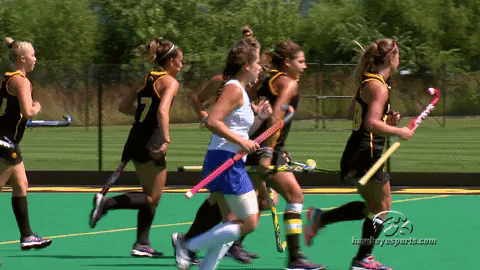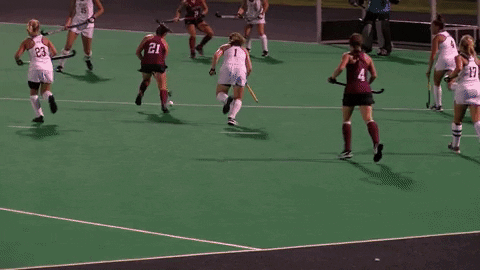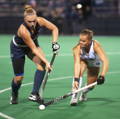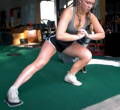Field Hockey Training - Does Strength Matter?
In the sport of field hockey, we believe there is a significant amount of underdevelopment when talking about different athletes and different positions in the sport. We also believe, especially when talking about women, that there tends to be under development in regards to resistance-based training. A lot of coaches are still in an archaic mindset where they don’t want to push women in the weight room. They talk about women getting big and bulky, losing speed, and turning into bodybuilders. Not the case. Bogus.

Recognize, especially for women’s field hockey, a massive amount of ground can be made up when getting involved with resistance-based training specific to field hockey. This is the same in the men’s game of field hockey. Field hockey athletes need to be fast and aggressive. The speed on the shot strives to be incredible. Strength endurance with incredible dynamic trunk control (DTC) are also needed skills for field hockey players, particularly athletes who want to compete at the highest levels of competition. This goes for females and males who participate in the sport of field hockey.
The best women in field hockey are jacked and fast. They look like developed athletes who hit the weight room. Strength training works.
4. Strength Endurance
We have to recognize that the game of field hockey is long. The games are challenging. The games are challenging cognitively as well. Field hockey athletes need to be fast running, agile, and demonstrate technical skills with the stick and vast amounts of coordination.
Strength-based training, resistance-based training, we have to recognize that field hockey athletes need to have strength endurance in the movements prescribed. It is pivotal we utilize isometrics, unilateral work, on-the-clock movements with the snatch, clean, and jerk, big drop-sets, or long-duration sets like a minute plus of walking lunges.

Now it is paramount that we periodize this properly so the athletes are not beat up playing the sport of field hockey. We still have to factor in strength endurance to the training though. We need to build in the cognitive skills into the training so the athletes can handle the technical skills late in the game and the stress that comes with the specific ball work. We also need to take into account positional differences in the amount of strength endurance that is needed verse the amount of speed-strength that is needed.
3. Mobility
Mobility is passive flexibility in various joints with stability. We have to have active movement through a large range of motion in specific joints.

In the sport of field hockey, we start thinking about reverse shots and passes, a block tackle, the knuckles being down on the ground, or the hips being extremely low. Not only the positions but the strength to hold those positions to not be knocked off course on the field. This means we need to train field hockey players through a full range of motion that targets various positions in the ankles, hips, knees, lower back, and even the upper back so they have tons of mobility through a large range of motions so they can apply a large amount of force to dominate opponents.
Mobility plays a pivotal role in taking and enhancing field hockey skills. Having the strength to hold specific positions, such as the hips being lower, makes it easier to hold the various stick positions.
We need to use a full range of motion doing goblet squats, back squats, split squats, front squats, or single-leg squats to improve mobility to have stability in all the various body positions used on the field.
2. Dynamic Trunk Control (DTC)
DTC is a key aspect of any sport in which athletes run with an object in hand. Like a stick to handle a ball.
But if we have our head down while dribbling we won’t be able to see the field or our opponents to forecast the moves we need to make to take advantage of our opponents. Now if we have a stable trunk, we can run more effectively. That gives us DTC. Being able to run more effectively allows us to carry the stick more effectively. Running effectively and being rigid in the trunk allows athletes to put more force into the ground to be faster as well.

On top of all of that, core strength lets us hold positions to be more stable, like in a block tackle. We can also cut more effectively with superior DTC.
We have to train DTC! Think about rotational striking. Training explosive rotational work, like side medicine ball work, or something as simple as a Pallof press, will help with rotational striking, improve DTC, and lead to a powerful striking of the ball.
Other great exercises to increase DTC include power snatching, power cleans, overhead lunges, and many more that can be utilized to enhance an athlete’s dynamic trunk control.
1. Speed Based Training
When we are on the field hockey field and we see athletes on opposing teams who have comparable skill levels the faster athlete will win out.

We can train unilateral strength to improve speed. We can target the hamstrings with movements like the Nordic hamstring pull to improve speed. We can work on lengthening the athlete’s stride, a specific technical skill involved in running mechanics.
Another key aspect is field hockey athletes need to be doing speed work, like plyometrics and other speed-based work, with their sticks. It is important to teach the athletes how to move rapidly and with speed while utilizing their sticks. The technical skills of the sport do matter to being fast on the field. This all will lead to greater speed on the field.
Understanding all four of these key elements is mandatory to developing greater on-the-field athletic capabilities in the sport of field hockey. Training strength endurance, speed, DTC, and mobility all contribute greatly to athletic capability on the field hockey competition field. With that being said, it is also important to periodize the exercises and focus appropriately to keep the body healthy and striving towards improving, which we are always happy to help with. So go ahead, apply these four concepts to training and let us know how it goes.
Leg Strength Exercises
When we are talking about improving leg strength with field hockey we need to consider what we need leg strength for. For instance, we need leg strength to get into a nice deep position to hold a block. We need leg strength to reverse pass or to cut rapidly while dribbling down the field. We need leg strength to decelerate, plant, cross, or anything else we need to do while running at full speed. Leg strength will transfer over to tremendous play. We can run quicker, improve our dynamic trunk control, see the field better, prevent lower back pain, and be less likely to get injured.
We can do a lot with better leg strength that leads to the team being better. In the sport of field hockey, we see a lot of lunging with the left leg leading because of the way the stick is built. Almost all the striking is predominantly done from the right side. It is important to realize this can lead to serious instability, which means we have to look at all the key factors behind field hockey, like strength endurance, mobility, dynamic trunk control, and speed.
It is important when looking at the four key strength exercises for the legs have to feed into the four key elements of strength endurance, mobility, dynamic trunk control, and speed.
4. Overhead Walking Lunge
The overhead walking lunge is great because it improves athletes’ dynamic trunk control. It also helps athletes iron out any insufficiencies they may have. Field hockey athletes are almost always leading with that left leg so maintaining structural integrity is important.

We can put a ten or fifteen-kilo plate overhead and alternate which leg lunges forward walking for four sets of forty seconds. We want to insure while lunging to get an equal amount of reps on each leg. The duration of the set helps train strength endurance. The plate overhead helps with dynamic trunk control. The posterior chain is trained to perform the lunge which helps with overall speed. The movement also helps with hip mobility. That covers all the elements.
We recommend doing overhead walking lunges for three to four sets of thirty to sixty seconds.
3. Pause Front Squat
A lot of field hockey players experience lower back pain because of a lack of strength and an inability to embrace the trunk to coordinate it properly with the legs. Front squats performed with a full range of motion with a rapid eccentric can reveal a weak back because we might see the athlete lean forward. Field hockey players are typically internally rotated forward because of the way they carry the stick. So if we have a rapid eccentric, athletes who are not strong enough will dump the weight and chest forward that might lead to lower back pain.

However, if we perform a front squat with a two to three-second eccentric, nice and controlled, with a pause in the hole for a solid two-count, staying nice and tight, squeezing through the belly button, squeeze through the entire back, feel nice and upright, and then drive up rapidly. Over time, as the athlete becomes stronger, their hips will become more mobile to become better defensive players, their ankles will become more mobile so they can cut better, run faster, and get into the drive phase better, and have better dynamic trunk control because of the pause position down in the hole.
Perform this movement twice a week. Go heavy one day and lighter the other day. Perform two to three sets for three to four reps.
2. Sliding Cossack Squat
Returning to the unilateral range, we want to start off nice and slow. The Cossack squat is a movement we want to progress through. We can start with an assisted Cossack squat. The goal is to achieve hip flexion in a really deep position. As the athlete gets more mobile and skillful with the movement, they can let go and perform a sliding goblet Cossack squat. That becomes too easy? Go ahead and go to an overhead position to try and open up the upper back and hips.

Utilize the sliding Cossack squat to improve lateral mobility, hip mobility, and to improve the strength in the groin. Better mobility gained from the exercise will allow field hockey athletes to lower their hips better out on the field, play deeper, and have more power from that deep position.
Do three sets of five to seven reps on each side for this exercise movement.
1. Pause Below Knee Power Snatch
Many strength coaches at the collegiate level shy away from this movement. They’ll say field hockey players don’t need to do this movement. We think this is a horrible mindset.
We want field hockey players to learn the progression to the snatch. Start with a snatch grip. Pull the bar off the ground and pause below the knee for three seconds. From there we want athletes to explode and perform the power snatch to propel the barbell overhead, catching the weight with the hips above parallel. This movement will help athletes open up their thoracic spine, help with thoracic rotation (think striking the ball with the stick), and on top of all that, the pause below the knee with a decent amount of hip flexion will strengthening the lower back.

The isometric muscular action from the pause will improve the recruitment of posterior chain muscles into the lower back, training the central nervous system to fire more aggressively to recruit very, very rapidly. This is key to being more explosive to hit the ball harder, defending with a block, and just flat our enhancing our overall performance.
Remember, when performing the power snatch, make contact off of the hip!
We recommend doing this movement three days a week. Do two technical days to learn how to coordinate effectively and push the weight one day a week to learn how to be more explosive with a higher load. Three to five sets of two to three reps can do the trick.
Recap
Use all four of these exercises to improve leg strength for field hockey to be more explosive on the field. Not only will field hockey athletes who perform these four exercises become faster on the field, but they will also find that they strike the ball with much greater force. The four exercises will enhance strength endurance, mobility, dynamic trunk control, and speed on the field. Try all four exercises and let us know which one is the best.
DANE MILLER
Dane Miller is the owner and founder of Garage Strength Sports Performance. He works with a select handful of clients on building comprehensive programs for fitness and nutrition. Several times a year he leads a workshop for coaches, trainers, and fitness enthusiasts.


